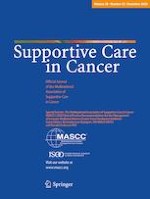Erschienen in:

26.03.2020 | Original Article
“Completely and utterly flummoxed and out of my depth”: patient and caregiver experiences during and after treatment for head and neck cancer—a qualitative evaluation of barriers and facilitators to best-practice nutrition care
verfasst von:
Merran Findlay, Nicole M. Rankin, Judith Bauer, Gemma Collett, Tim Shaw, Kathryn White
Erschienen in:
Supportive Care in Cancer
|
Ausgabe 12/2020
Einloggen, um Zugang zu erhalten
Abstract
Background
Malnutrition is prevalent in patients with head and neck cancer (HNC), impacting on outcomes. Despite publication of best-practice nutrition care clinical guidelines, evidence-practice gaps persist.
Aim
This project aimed to understand the perspectives of patients and their caregivers about nutritional care and how their unmet supportive care needs can be better addressed in designing a new model of care (MOC). The results will contribute to documenting the barriers and enablers to implementing best practice nutrition care for patients with HNC.
Method
Qualitative interviews were conducted with patients who had completed radiotherapy with or without (+/−) other treatment modality (surgery and/or systematic therapy) of curative intent for HNC. Patients were purposively sampled from a major tertiary referral centre in Sydney, Australia. Patients’ primary caregivers were also invited to participate if both parties consented. A semi-structured interview schedule was developed to elicit information about barriers and facilitators to change and inform development of the new MOC. Interviews were transcribed verbatim then analysed using an inductive thematic approach. This study was one component of a mixed methods design to explore the barriers and facilitators to best-practice nutrition care in a head and neck oncology unit.
Results
Eleven participants (seven patients, four caregivers) took part in the interviews. Four key themes were identified with branching themes within each: (1) being ill-prepared for the impact of treatment, even when advised; (2) navigating complex systems to meet significant care needs; (3) depleted by overwhelming and prolonged suffering; and (4) information lost in translation.
Conclusions
This study highlights the unique and complex care needs of people with HNC and those caring for them. To design and successfully deliver a patient-centred MOC, specific strategies will be required to address: early and ongoing access to expert supportive care clinicians; integrated and coordinated care; individual information, education and support needs and; and education of MDT staff in accurate and consistent messaging, ensuring nutrition care is a collective responsibility. Nutrition care did not appear to be viewed separately to overall care from the patient perspective as the importance of nutrition ultimately became viewed as vital treatment.











